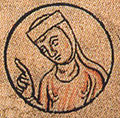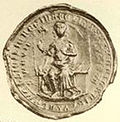Queen of Alamannia
Carolingian dynasty, 876–882
| Picture | Name | Father | Born | Wed | Husband | Became Consort | Ceased to be Consort | Died |
|---|---|---|---|---|---|---|---|---|
 | Richardis of Swabia | Erchanger, Count of the Nordgau (Ahalolfinger) | 840 | 1 August 862 | Charles the Fat | 28 August 876 Partition of East Francia | 20 January 882 Reunification of East Francia | 18 September, between 894 and 896 |











